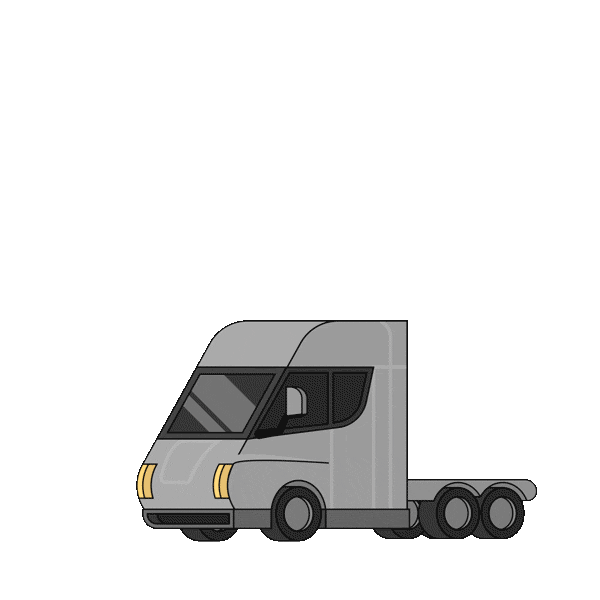Everyone is crying out for a transformation of the truck. Businesses and hauliers want to reduce their fuel bills after a decade of stagnant fuel efficiency rates in Europe. They also need trucks to change if they are to reduce their climate impact like other sectors. The European market wants heavy-duty vehicles to follow the trends seen in the US where CO2 standards reduced the total cost of ownership of trucks there. And our planet needs trucks to change: they make up just 2% of vehicles on our road yet account for 22% of vehicle greenhouse gas emissions.
The only group happy with business as usual is the truckmakers. German and European truck lobby groups spent much of 2018 urging EU lawmakers to weaken the planned emission reduction targets so they can keep selling even dirtier diesel lorries for another decade and as few electric trucks as possible. T&E analysis showed that new trucks in 2025 could be even less fuel efficient than those in 2019, if lawmakers followed the wishes of European truckmakers.
Taking care of business
Last April the other side of the trucking business – the customers – made their case to European Commission president Jean-Claude Juncker. IKEA, Unilever, Carrefour and Nestlé were among the companies, logistics groups and hauliers to write to the president asking for an EU target of reducing emissions from new trucks by almost a quarter. This, they argued, would help them meet their climate goals and save €7,700 per year, per truck. They also called for an ambitious mandatory sales target for zero emission trucks. In mid-May the Commission proposed a 15% truck CO2 reduction in 2025 – short of the ambition demanded by hauliers and businesses, and short of what would be needed to hit the EU’s own climate goals.

T&E had long pushed for the EU to set its first ever truck CO2 reduction targets, but was not ready to settle for a mediocre proposal. To convince sceptical lawmakers to be more ambitious, we made the economic case: decarbonising road freight would cut oil imports by 1 billion barrels of oil equivalent by 2030, would strengthen GDP and would create around 120,000 net additional jobs across the economy, an analysis by Cambridge Econometrics indicated.
The bell tolls for distance charging
The American experience of CO2 standards was also instructive. Before standards, the price of new trucks was rising in the US but fuel consumption didn’t improve. After standards buyers began paying around $400 more per new truck but in return they got an average of $1,400 of additional fuel savings every year, data analysed by T&E showed.
But an on-road CO2 test – known as VECTO – also needed to be put in place. T&E pushed for truckmakers to be required to make public the aerodynamic performance of the tractor unit of the truck, as well as its engine fuel efficiency. This transparency would allow hauliers to make informed purchasing decisions, driving truckmakers to be competitive on fuel efficiency and CO2 emissions reductions. We also pushed for distance-based road tolls for trucks, so that vehicles would pay for the CO2 emissions they emit, incentivising cleaner trucking. Endorsing the Commission’s proposal, MEPs called for truckers, from 2023 onwards, to no longer be able to pay by duration – per day, week, month, etc – to drive unlimited distances, and will instead pay per km. MEPs want charges to be differentiated based on CO2 emissions – with zero-emission trucks having a 50% discount. EU countries would be able to decide how much to charge for the vehicle’s air pollution and noise, with minimum charges set down in EU law. The legislation is expected to be finalised in the new parliamentary term, starting in 2019.
T&E also kept up the pressure to improve truck safety. In May, the Commission had proposed that all new models should comply with a ‘direct vision requirement’ in their cabs by 2026 for new models, and by 2029 for all new trucks sold. The direct vision standard would define the area surrounding a truck cab that the driver must be able to see without using mirrors or cameras – crucial towards reducing the 4,000 truck-related deaths in Europe every year. But the Commission’s deadline was too lax, and the direct vision standard too vague. We worked with the mayor of London and others to push for faster, better implementation.
Smoothing the way
There was progress too on truck cab design. In addition to CO2 targets and vehicle safety, the Commission proposed to cut short the controversial three-year moratorium delaying rounder, more aerodynamic cabs from coming on to the market. The moratorium would be cut to four months, allowing the new cabs to hit Europe’s roads in 2020. The legislation is set to be made law in 2019.
As the year came to a close, the European Parliament voted to increase the ambition of the Commission’s emissions reduction targets to a 20% cut in 2025, and at least 35% in 2030. They also demanded that truckmakers would have to meet a target for zero-emission trucks of 5% of sales in 2025 – with less stringent CO2 targets for those selling a greater share. EU governments were not as ambitious but nonetheless were willing to consider such a sales benchmark. However, ministers were less stringent on CO2 reduction, calling for targets of 15% in 2025 and 30% in 2030.
But the Commission’s own long-term climate strategy was clear about the effort that will be required: combustion trucks would need to be phased out in the 2030s. T&E’s analysis of the role of gas in transport had already made it clear that trucks running on gas emitted as much carbon emissions as diesel ones. In fact, there wouldn’t even be a business case for gas-powered trucks if the fuel was taxed at the same rates as diesel.
Other campaigns
Planes
Loud and stingy vs silent and smooth. Which one do you bet on?
Ships
Dirty and smelly vs careful and discreet. Which one do you bet on?
Energy
Expensive and unreliable vs cheap and renewable. Which one do you bet on?




